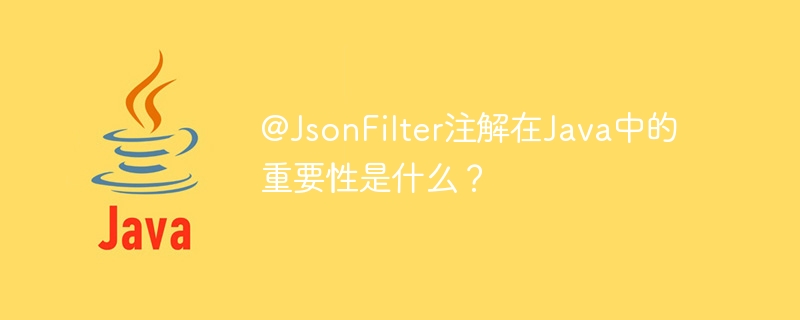What is the importance of @JsonFilter annotation in Java?

@JsonFilter annotation is used to define custom filters to serialize Java objects. We need to use the FilterProvider class to define the filter and get the actual filter instance. Now configure the filter by assigning the FilterProvider to the ObjectMapper class.
Syntax
@Target(value={ANNOTATION_TYPE,TYPE,METHOD,FIELD,PARAMETER})
@Retention(value=RUNTIME)
public @interface JsonFilterIn the example below, customFilter can be declared as a parameter of the @JsonFilter annotation, which only extracts the name and filters Drop the other attribute beans of a.
Example
import com.fasterxml.jackson.annotation.JsonFilter;
import com.fasterxml.jackson.databind.ObjectMapper;
import com.fasterxml.jackson.core.JsonProcessingException;
import com.fasterxml.jackson.databind.ser.FilterProvider;
import com.fasterxml.jackson.databind.ser.impl.SimpleBeanPropertyFilter;
import com.fasterxml.jackson.databind.ser.impl.SimpleFilterProvider;
public class JsonFilterAnnotationTest {
public static void main(String args[]) throws JsonProcessingException {
ObjectMapper mapper = new ObjectMapper();
FilterProvider filterProvider = new SimpleFilterProvider().addFilter("customFilter", SimpleBeanPropertyFilter.filterOutAllExcept("empName"));
String jsonString = mapper.writer(filterProvider).writeValueAsString(new FilterBean());
System.out.println(jsonString);
}
}
@JsonFilter("customFilter")<strong>
</strong>class FilterBean {
public int empId = 110;
public String empName = "Raja Ramesh";
public String gender = "male";
}Output
{"empName":"Raja Ramesh"}The above is the detailed content of What is the importance of @JsonFilter annotation in Java?. For more information, please follow other related articles on the PHP Chinese website!

Hot AI Tools

Undress AI Tool
Undress images for free

Undresser.AI Undress
AI-powered app for creating realistic nude photos

AI Clothes Remover
Online AI tool for removing clothes from photos.

Clothoff.io
AI clothes remover

Video Face Swap
Swap faces in any video effortlessly with our completely free AI face swap tool!

Hot Article

Hot Tools

Notepad++7.3.1
Easy-to-use and free code editor

SublimeText3 Chinese version
Chinese version, very easy to use

Zend Studio 13.0.1
Powerful PHP integrated development environment

Dreamweaver CS6
Visual web development tools

SublimeText3 Mac version
God-level code editing software (SublimeText3)
 edge pdf viewer not working
Aug 07, 2025 pm 04:36 PM
edge pdf viewer not working
Aug 07, 2025 pm 04:36 PM
TestthePDFinanotherapptodetermineiftheissueiswiththefileorEdge.2.Enablethebuilt-inPDFviewerbyturningoff"AlwaysopenPDFfilesexternally"and"DownloadPDFfiles"inEdgesettings.3.Clearbrowsingdataincludingcookiesandcachedfilestoresolveren
 Deploying a Java Application to Kubernetes with Docker
Aug 08, 2025 pm 02:45 PM
Deploying a Java Application to Kubernetes with Docker
Aug 08, 2025 pm 02:45 PM
Containerized Java application: Create a Dockerfile, use a basic image such as eclipse-temurin:17-jre-alpine, copy the JAR file and define the startup command, build the image through dockerbuild and run locally with dockerrun. 2. Push the image to the container registry: Use dockertag to mark the image and push it to DockerHub and other registries. You must first log in to dockerlogin. 3. Deploy to Kubernetes: Write deployment.yaml to define the Deployment, set the number of replicas, container images and resource restrictions, and write service.yaml to create
 How to implement a simple TCP client in Java?
Aug 08, 2025 pm 03:56 PM
How to implement a simple TCP client in Java?
Aug 08, 2025 pm 03:56 PM
Importjava.ioandjava.net.SocketforI/Oandsocketcommunication.2.CreateaSocketobjecttoconnecttotheserverusinghostnameandport.3.UsePrintWritertosenddataviaoutputstreamandBufferedReadertoreadserverresponsesfrominputstream.4.Usetry-with-resourcestoautomati
 VS Code shortcut to focus on explorer panel
Aug 08, 2025 am 04:00 AM
VS Code shortcut to focus on explorer panel
Aug 08, 2025 am 04:00 AM
In VSCode, you can quickly switch the panel and editing area through shortcut keys. To jump to the left Explorer panel, use Ctrl Shift E (Windows/Linux) or Cmd Shift E (Mac); return to the editing area to use Ctrl ` or Esc or Ctrl 1~9. Compared to mouse operation, keyboard shortcuts are more efficient and do not interrupt the encoding rhythm. Other tips include: Ctrl KCtrl E Focus Search Box, F2 Rename File, Delete File, Enter Open File, Arrow Key Expand/Collapse Folder.
 How to execute a prepared statement in Java?
Aug 06, 2025 pm 04:04 PM
How to execute a prepared statement in Java?
Aug 06, 2025 pm 04:04 PM
Load the JDBC driver and establish a database connection; 2. Use Connection.prepareStatement() to create a SQL statement containing a placeholder; 3. Call setString(), setInt() and other methods to set parameter values from 1; 4. Call executeUpdate(), executeQuery() or execute() according to the SQL type to execute statements; 5. Use try-with-resources to automatically close the Connection, PreparedStatement and ResultSet resources to prevent memory leaks and ensure safe and efficient processing of database operations.
 How to use Mockito for mocking in Java?
Aug 07, 2025 am 06:32 AM
How to use Mockito for mocking in Java?
Aug 07, 2025 am 06:32 AM
To effectively use Mockito for Java unit testing, you must first add Mockito dependencies, add mockito-core dependencies in the Maven project, and add testImplementation'org.mockito:mockito-core:5.7.0' to the Gradle project; then create mock objects through @Mock annotation (combined with @ExtendWith(MockitoExtension.class)) or mock() method; then use when(...).thenReturn(...) and other methods to stub the method behavior of the mock object, or you can also configure different
 What is the process of serialization for a Java object?
Aug 08, 2025 pm 04:03 PM
What is the process of serialization for a Java object?
Aug 08, 2025 pm 04:03 PM
Javaserializationconvertsanobject'sstateintoabytestreamforstorageortransmission,anddeserializationreconstructstheobjectfromthatstream.1.Toenableserialization,aclassmustimplementtheSerializableinterface.2.UseObjectOutputStreamtoserializeanobject,savin
 How to use a while loop in Java
Aug 08, 2025 pm 04:04 PM
How to use a while loop in Java
Aug 08, 2025 pm 04:04 PM
AwhileloopinJavarepeatedlyexecutescodeaslongastheconditionistrue;2.Initializeacontrolvariablebeforetheloop;3.Definetheloopconditionusingabooleanexpression;4.Updatethecontrolvariableinsidethelooptopreventinfinitelooping;5.Useexampleslikeprintingnumber







